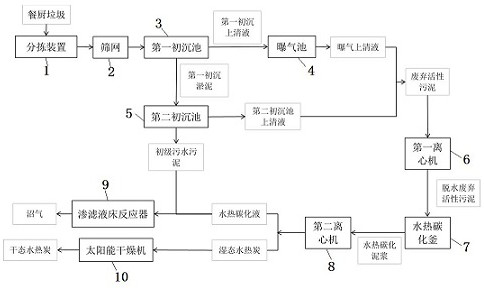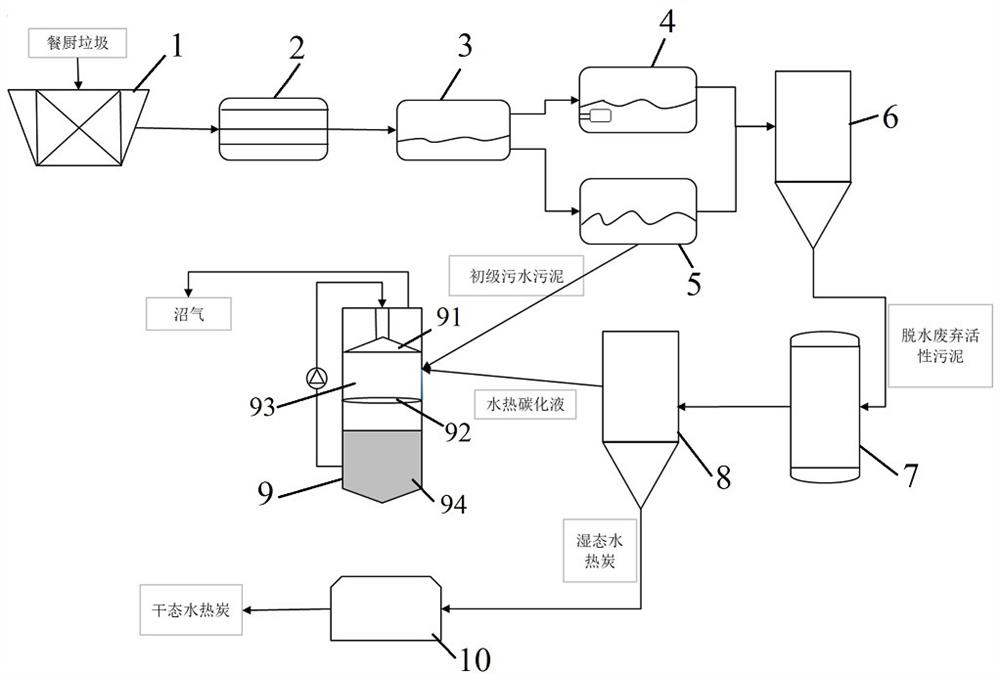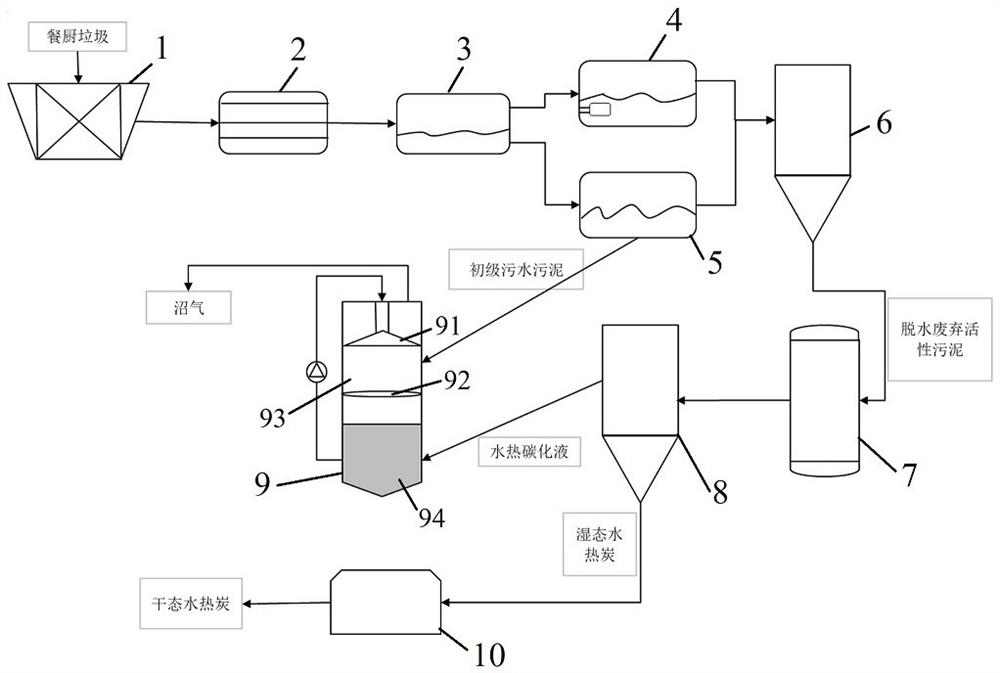A method for harmless treatment of kitchen waste
A technology for harmless treatment of food waste, applied in chemical instruments and methods, sludge treatment, sedimentation treatment, etc., can solve the problems of long time-consuming treatment of food waste, slow digestion rate, low yield of hydrothermal charcoal, etc. problem, to achieve the effect of improving improvement ability, uniform size, and improving anaerobic digestibility
- Summary
- Abstract
- Description
- Claims
- Application Information
AI Technical Summary
Problems solved by technology
Method used
Image
Examples
Embodiment 1
[0036] see Figure 1-2 , is a kind of food waste harmless treatment method of the present invention, comprises the following steps:
[0037] 1) Sorting the collected kitchen waste by using the sorting device 1 to sort the coarse solid waste, and using the screen 2 to screen out the silt and gravel;
[0038] 2) the mixture obtained in step 1) is transferred to the first primary sedimentation tank 3 for sedimentation;
[0039]3) Transfer the first primary sedimentation supernatant obtained after the primary sedimentation in the first primary sedimentation tank 3 in step 2) to the aeration tank 4, and transfer the first primary sedimentation sludge obtained after the primary sedimentation to the second primary sedimentation tank Settling in the primary sedimentation tank 5;
[0040] 4) The sludge obtained by mixing the aeration supernatant liquid aerated in step 3) through the aeration tank 4 and the second primary sedimentation supernatant liquid obtained after the second prim...
Embodiment 2
[0046] see figure 1 , image 3 , a method for harmless treatment of kitchen waste provided by the present invention, comprising the following steps:
[0047] 1) Sorting the collected kitchen waste by using the sorting device 1 to sort the coarse solid waste, and using the screen 2 to screen out the silt and gravel;
[0048] 2) the mixture obtained in step 1) is transferred to the first primary sedimentation tank 3 for sedimentation;
[0049] 3) Transfer the first primary sedimentation supernatant obtained after the primary sedimentation in the first primary sedimentation tank 3 in step 2) to the aeration tank 4, and transfer the first primary sedimentation sludge obtained after the primary sedimentation to the second primary sedimentation tank Settling in the primary sedimentation tank 5;
[0050] 4) The sludge obtained by mixing the aeration supernatant liquid aerated in step 3) through the aeration tank 4 and the second primary sedimentation supernatant liquid obtained af...
Embodiment 3
[0056] see figure 1 , image 3 , a method for harmless treatment of kitchen waste provided by the present invention, comprising the following steps:
[0057] 1) Sorting the collected kitchen waste by using the sorting device 1 to sort the coarse solid waste, and using the screen 2 to screen out the silt and gravel;
[0058] 2) the mixture obtained in step 1) is transferred to the first primary sedimentation tank 3 for sedimentation;
[0059] 3) Transfer the first primary sedimentation supernatant obtained after the primary sedimentation in the first primary sedimentation tank 3 in step 2) to the aeration tank 4, and transfer the first primary sedimentation sludge obtained after the primary sedimentation to the second primary sedimentation tank Settling in the primary sedimentation tank 5;
[0060] 4) The sludge obtained by mixing the aeration supernatant liquid aerated in step 3) through the aeration tank 4 and the second primary sedimentation supernatant liquid obtained af...
PUM
 Login to View More
Login to View More Abstract
Description
Claims
Application Information
 Login to View More
Login to View More - R&D
- Intellectual Property
- Life Sciences
- Materials
- Tech Scout
- Unparalleled Data Quality
- Higher Quality Content
- 60% Fewer Hallucinations
Browse by: Latest US Patents, China's latest patents, Technical Efficacy Thesaurus, Application Domain, Technology Topic, Popular Technical Reports.
© 2025 PatSnap. All rights reserved.Legal|Privacy policy|Modern Slavery Act Transparency Statement|Sitemap|About US| Contact US: help@patsnap.com



